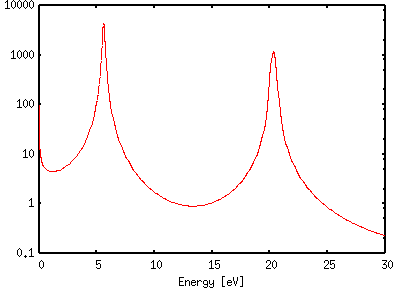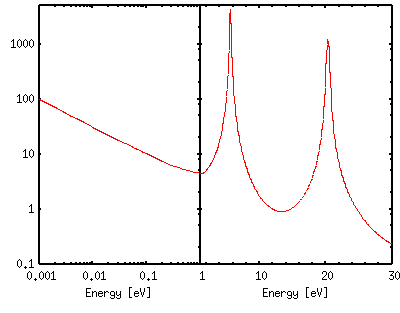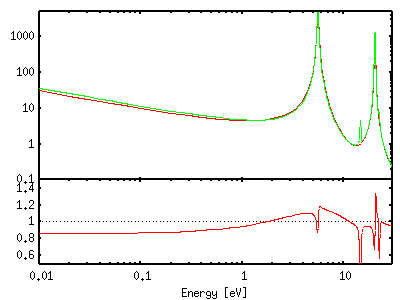|
Here we present a method to align two figures vertically or
horizontally, those are essentially the same data but in a
different appearance. You probably need such a figure in the next
cases.
- Place two figures in a different scale.
- When you want to enlarge a certain X-range. For example, you want
to magnify the small X region and plot the data there with a
log-scale, and the other part is in a linear scale.
- Compare two similar data with each other
by absolute values and ratio.
- When you are plotting two different data whose Y values are
very close each other, you are probably very hard to
distinguish two lines. If you want to show the fact that
those two data are very similar, such a figure might be OK.
However, if you want to show the similarity of those data
quantitatively, you can calculate a ratio of one data to the
other, and plot them to show the deviation from ratio=1. We
divide one figure into two parts, and plot a comparison of
the absolute values in the upper potion, and the lower is
the ratio of them.
 
Here is an example data. This figure shows the X-range of [0:30],
but the data near X=0 are also important, and you want to show
there in detail. Of course you can make two figures in a different
scale, but we combine those two. Firstly we plot the data below 1
in the log-scale.
gnuplot> set log xy
gnuplot> set xrange [ 0.001 : 1 ]
gnuplot> set yrange [ 0.1 : 5000 ]
gnuplot> set xlabel "Energy [eV]"
For the data in [1:30] we use the linear-scale plot, and we place
this adjacent to the log-scale figure by using multiplot
. In order to adhere the high-X region figure (right side) to
the low-X (left side), we let the rmargin of left figure
be zero, and lmargin of the right side is also zero. The
width of those two figure is a half of full-width, then the right
side figure is sifted by 0.5 by using set origin .
We need the Y-tics for the left side figure, but we don’t need it
for the right side. So that set lmargin 10 is defined
for the left, while lmargin is zero for the right. In
addition, set format "" erases
Y-axis values.
gnuplot> set multiplot
multiplot> set size 0.5,1
multiplot> set origin 0.0,0.0
multiplot> set lmargin 10
multiplot> set rmargin 0
multiplot> plot "calc.dat" u 1:2 w l
multiplot> set origin 0.5,0.0
multiplot> set format y ""
multiplot> set lmargin 0
multiplot> set rmargin 2
multiplot> set nolog x
multiplot> set xrange [1:30]
multiplot> set xtic 0,10
multiplot> set mxtic 5
multiplot> plot "calc.dat" u 1:2 w l
multiplot> set nomultiplot
gnuplot>

You have to say clearly that the figures on the left and right are
in the different scale. To do this we put minor tics on the X-axis.
At the border between two drawings, sometimes X-axis numbers are
overlapped. The command set xtics 0,10(initial value 0,
increment 10) avoids the tics at X=1.
By the way, we know that this example data become linear in a log-log scale
at small X-values, because this is some physical quantity.
It is possible to demonstrate such a characteristic very easily
if you divide one figure into two regions.
In this example the X-axis name is drawn twice, but you can make it
one in the middle of the whole figure. For the left side, you erase
the axis name by set xlabel "", and move the label on the
right side by set xlabel "Energy [eV]" -20,0. In this case
you need to set bmargin 5 to fix the bottom margin.
If you want to compare two sets of data those are very close, it is
useful that those data are plotted absolutely, and the ratio of
those data are given at the same time. The comparison of absolute
values are in the log-scale which goes upper part, while the ratio
is in the linear-scale shown in the lower part.
In order to calculate the ratio of one data to another, the X values
of those data should be the same. In our data file, the first column
contains the X value, the second column is the Y value of the first
data set, and the third column is the Y of second set.
Firstly we set some X-axis parameters those are common to the upper
and lower figures. The X range is [0.01:30]. To make the width of
those figures be the same, we define margins of left and right sides
explicitly.
gnuplot> set xrange [ 0.01 : 30 ]
gnuplot> set nokey
gnuplot> set log x
gnuplot> set xtics 10
gnuplot> set mxtics 10
gnuplot> set lmargin 10
gnuplot> set rmargin 2
Make the lower part which shows the ratio data. The hight is
reduced to 0.4, the Y-range is from 0.5 to 1.5, and put the
graduations from 0.6 to 1.4 with the interval of 0.2. To make a
space of the X-axis name, use set bmargin, and to attach
the upper part, set tmargin 0 removes the extra-space
above. The Y values of two data sets are in the second and third
column of the data file. To plot the ratio of the first data to the
second ones, plot 1:($2/$3). In addition, a straight line
of Y=1 is helpful to show the ratio data.
gnuplot> set multiplot
multiplot> set yrange [ 0.5 : 1.5 ]
multiplot> set ytic 0.6,0.2,1.4
multiplot> set ylabel "Ratio"
multiplot> set size 1,0.4
multiplot> set xlabel "Energy [eV]"
multiplot> set origin 0.0,0.0
multiplot> set bmargin 3
multiplot> set tmargin 0
multiplot> plot 1 w l 0,"cross.dat" u 1:($2/$3) w l 1
Now we make the upper part. Make the size smaller, move the origin
to the left-top corner of the lower part. The two data sets are
shown in the log-scale. set bmargin 0 removes the
extra-space below. The X-axis name and numbers should be
erased.
multiplot> set log xy
multiplot> set yrange [ 0.1 : 5000 ]
multiplot> set ytic 0.1,10
multiplot> set ylabel "Cross Section [b]"
multiplot> set size 1,0.6
multiplot> set origin 0.0,0.4
multiplot> set bmargin 0
multiplot> set tmargin 1
multiplot> set format x ""
multiplot> set xlabel ""
multiplot> plot "cross.dat" u 1:2 w l,"" u 1:3 w l
multiplot> set nomultiplot
gnuplot>

Since we erased the legend in this example, it is not easy to
understand that the ratio shown here is A to B, or B to A. If you
see the upper figure, you might recognize that this is the ratio of
red curve to the green curve, because the red is lower than the
green. However such a statement should be given in a caption of
this figure.
You can see an example of EPS in
our gallery.
|





